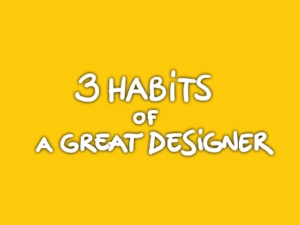You are here
Add new comment
3 Habits of a Great Designer by Jaanus Sakkis
Submitted by sopio on 26 November 2014 - 2:58pm
For about a month now, I have been working in Kampala, mentoring many designers and teams of various backgrounds. I cannot say, that the design field in Uganda differs dramatically from Europe, as one could have expected. So far, I can confidently underline the fact, that though the technical skills are quite strong, the main concern I see here, is the clear deliverance of a message – the lacking in communication. In this short article, I have compiled an overview of some of the questions and problems that both designers and aspireing designers have asked me while I have been working here.
What makes a designer into a great designer?
Communication.
The main carrying function of a designer is communication. In order to deliver a message in a simple, clear and comprehensible manner, you need to be fluent not only in visual communication, but, in addition, just as much in verbal communication.
3 of the most commonly encountered mistakes:
Not enough focus and attention on the client and the problem at hand
The lack of concentrated, attentive focus in communicating with a client might easily be the fault on the clients part of the conversation, nevertheless, a good designer is always able to ask the right questions in order to steer the client in the direction of opening up the problem.
*Before talking about the design project, you need to do all on your part, to make the meeting happen at all. If you are half an hour late for a meeting or do not show up at all, you can expect to be shut out for further cooperation. If you want to get the biggest, most interesting and rewarding projects, then punctuality and reliability are hugely important assets on your part. Communication helps you along in these situations – in case you know you might have trouble getting to the meeting, simply let your clients know, because people value their time and you will not get a second chance if you are unrespectful.
Lack of empathy for the problem
One of the main issues with beginner designers is a problem with their ability to go thoroughly into the problem, not just the design problem, but the whole idea behind it. Fortunately, it is one of the easiest lackings to mend – you learn with experience. A good designer can not be just a pencil holder, but an incubator of ideas, who can dive into an idea or problem and see the opportunities and solutions, that the client is maybe too close or too closed to see. One simple, yet hugely important notion you need to keep in mind, is that you are not your user! You might have buried in your head a ton of information related to your product, but, and I emphasize this, it is only in your own head. The human brain is a clever machine that can fill up the gaps in a puzzle, but only if you have the pieces. Do not create riddles for your clients, that only you can comprehend, it is your job to solve the puzzle and hand out the simplest possible solution. Unless you are building a puzzle-game for your client, in that case, go ahead J
Test your product
Testing your product does not mean that you play it out and find that everything seems sensible and intuitive. It means that you are the scientist overseeing the mice opening the cookie jar. Be patient! Do not get frustrated, if you see the user having trouble finding the button, even if it is the only one on the screen, just be patient and observe – this is just what you need. The situation, where your user gets tangled, this is your challenge, it is your chance to locate and solve the problem. It is an opportunity to improve your product usability. A good product or service can only grow out of fluent cooperation between designer and user. Do not assume anything – test it! You simply have to welcome criticism and let yourself evolve. You need to see problems, not as worries, but instead, as a force that makes you think outside the box and find new solutions.
Communication is the foundation of modern society and your aim, as a designer, is to forward information in the clearest form possible. So, think, really think about it – what is your message?


